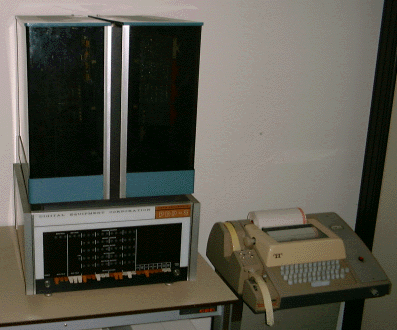DEC PDP-8 minicomputer
UvA Computer Museum catalogue nr 96.17

From the DEC (UK) Ltd. 1967 pricelist we quote:
PDP-8 (T) Standard PDP-8 in Table Top form. Includes 12-bit word 4k memory. 10ch/sec papertape I/O in free-standing on-line typewriter (ASR-33). Expandible Data Break Channel (1 or 3 cycle mode) for direct I/O access to memory. Family-of-eight compatible. 1.5 µs memory cycle, 3 µs addition time. List Price £7,700.[........]
Type 183 Memory Extension Control. Allows extension of core memory from 4K to 32K (32,768) words by addition of Type 184 4K Memory Modules. Does not slow instruction rate, nor compromoise basic processor registers. Additional auto-indexing available with memory expansion. List Price £725.
[.......]
Type 184 Memory Module No Parity. 4K (4,096) word 12 bit core memory module 1.5 µs read-write cycle time, 400 ns access time. Needs Type 183. List Price £3,600.
[.......]
Type DF32 Disc File and Control (DECdisc). Random access, word addressable, bulk storage device and control operating through 3-cycle Data Break facility on the PDP-8. Storage capacity - 32K 13-bit words. Data Transfer Rate - 80 µs per word at 50 c/s power. Average access time 20 ms. Block transfer size variable 1 to 4096 words. List Price £2,900.
This machine was used with the BOL project at the IKO institute for nuclear physics, Amsterdam
